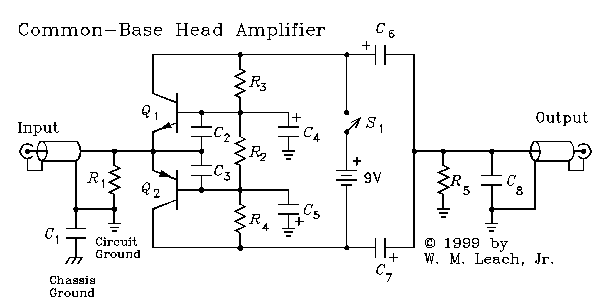Your basket is currently empty!

Richard Lee’s Ultra-Low Noise MC Head Amp
This design was a development of Marshall Leach’s MC head-amp, from the 1970s, and to my knowledge, Richard Lee’s implementation presented here has not been bested in terms of noise – about 280pV/rt Hz in a well-implemented exemplar – other than in the Hifisonix X-Altra MC/MM Phono Preamplifier. Importantly, it requires only about 12mA current in the +-15V rail powered version, and about a quarter of that in the battery version. If you try to achieve this type of performance with single-ended designs using PNP devices (the Diodes Inc ZTX951 being an excellent candidate), you will probably require 10 times the current of the battery-powered version or an opamp and a lot more circuit complexity.
The original design back in 1980 was housed in a discarded ‘Duraglit’ tin (a type of polish in the UK used to burnish soft metals like brass, aluminum or pewter), and this design has thus become known amongst the DIY fraternity as ‘Richard Lee’s Duraglit Special’
The design is not without its foibles in that it requires low rbb’ NPN-PNP complements, now (2019) difficult to get (other than the excellent Zetex ZTX851/951 types) and the gain is dependent upon the cartridge DC resistance – so you have to select the output load resistor appropriately. Nevertheless, it is a fantastic example of the ‘less is more’ dictum and achieves remarkable performance for pennies.
Lee worked for various UK Hi-Fi outfits in the heyday of home audio in the 1960’s through 1980’s, including a stint at KEF and is now retired to Cooktown, Queensland, Australia where he relishes living as a ‘beach bum’ (his words, not mine!).
Comments
2 responses to “Richard Lee’s Ultra-Low Noise MC Head Amp”
Hello Ron,
the circuits would work and I’d say the ‘Hawking’ or the ‘Newton’ will give you the lowest noise circuit possible using your devices. Good luck with your build.
(NB – please see the notes at the back of the updated presentation re-shielding etc for these circuits – very important.)
For low Rbb transistors there is the 2n4401/03 types which are not as low as the ZTX, (about 40 ohms), but should be OK. – As I have a few in stock, what do you think ?
Leave a Reply